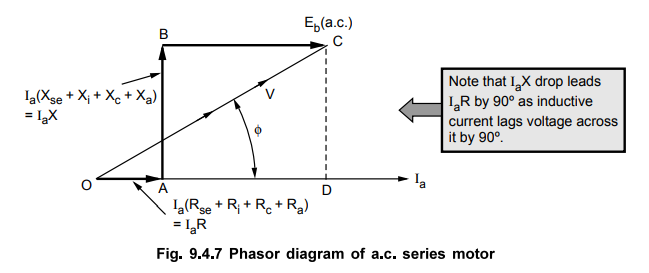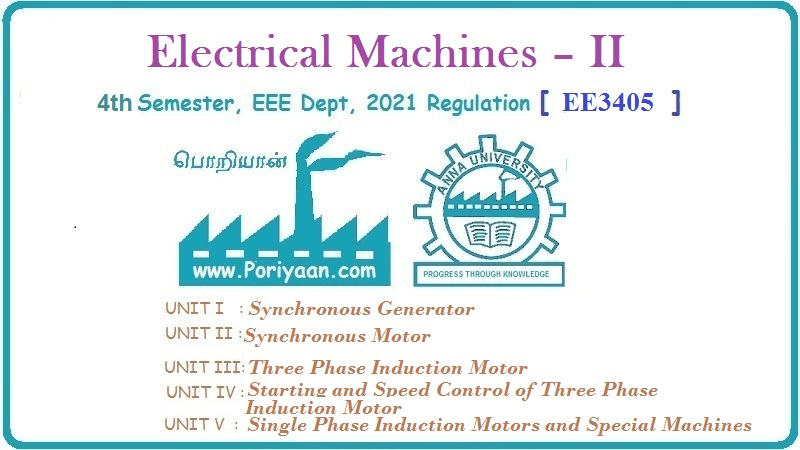Electrical Machines II: UNIT V: b. Special Machines
Two Marks Questions with Answers
Special Machines | Electrical Machines
Engineering Electrical Machines - II : UNIT V : Special Machines : Anna University Two Marks Questions & Answers
Two Marks Questions with Answers
Q.
1 Why is the hysteresis motor free from mechanical and magnetic vibrations ? AU
: May-03
Ans. :
The
stator of hysteresis motor carries main and auxiliary windings to produce
rotating magnetic field or of shaded pole type also. The rotor is smooth
cylindrical type made up of hard magnetic material. The torque in this motor is
constant at all speeds. It runs at synchronous speed. There is not relative
motion between stator and rotor field so the torque due to eddy currents
vanishes. Only hysteresis torque is present which keeps rotor running at
synchronous speed. The high retentivity ensures continuous magnetic locking between
stator and rotor. Hence it is free from magnetic vibrations. Since there are no
teeth, no winding there are no mechanical vibrations. Hence the operation is
quiet and noiseless.
Q.
2 What type of motor is used in computer drives and wet grinders ?
Ans. :
Stepper
motor is used in computer drives and universal motor is used for wet grinders.
Q.
3 Give two advantages and two applications of stepper motor. AU : May-04, 08,
Dec.-07
Ans. :
The
advantages are, fast dynamic response, rotor construction is robust, high
torque to inertia ratio, high rates of acceleration, smaller step angles.
The
applications are, computer peripherals, serial printers, actuators,
spacecrafts, robotic control systems, numerical control of machines tools, disc
drives etc.
Q.
4 List some applications of linear induction motors.
Ans. :
They
are used in machine tool industry and in robotics for positioning and operation
of manipulators, in trains operated on magnetic levitation and reciprocating
compressors.
Q.
5 What are the specific characteristic features of the repulsion motor ?
Ans. :
Repulsion
motors give excellent performance characteristics. A very high starting torque
of about 300 to 350 % of full load can be obtained with starting current of
about 3 to 4 times the full load current. Thus it has got very good operating
characteristics. The speed of the motor changes with load. With compensated
type of repulsion motor, the motor rims with improved power factor as the
quadrature drop in the field winding is neutralised. Also the leakage between
armature and field is reduced which gives better speed regulation.
Q.
6 Discuss the characteristics of single phase series motor.
Ans. :
1)
Yoke and poles construction is laminated to reduce eddy current losses.
2)
Compensating winding is necessary for reducing the difficulties in commutation
and armature reaction.
3)
Excellent starting torque and characteristics are comparable to d.c. series
motor.
4)
Due to modification problem, manufactured in small sizes and having fractional horse
power ratings.
Q.
7 What are the demerits of repulsion motor ?
Ans. :
1)
Very expensive. 2) Speed changes with load. 3) On no load , speed is very high
causing sparking at brushes. 4) Low power factor on no load. 5) Noisy
operation. 6) Periodic commutator maintenance is required.
Q.
8 List four applications of reluctance motors.
Ans. :
It
is used in signaling devices, automatic regulators, recording instruments,
clocks and timing devices, teleprinters etc.
Q.
9 What is a universal motor ?
Ans. :
Universal
motor is small capacity series motor which can be operated on d.c. supply or
single phase a.c. supply of same voltage with similar characteristics.
Q.
10 List the advantages of reluctance motor.
Ans. :
1)
No d.c. supply is necessary for rotor.
2)
Constant speed characteristics.
3)
Robust construction.
4)
Less maintenance.
Q.
11 State the limitations of reluctance motor.
Ans. :
1)
Less efficiency
2)
Poor power factor
3)
Need of very low inertia rotor.
4)
Less capacity to drive the loads.
Q.
12 State the advantages of hysteresis motor.
Ans. :
1)
As rotor has no teeth, no winding, there are no mechanical vibrations.
2)
Due to absence of vibrations, the operation is quiet and noiseless.
3)
Suitability to accelerate high inertia loads
4)
Possibility of multi speed operation by employing gear train.
Q.
13 State the applications of hysteresis motor.
Ans. :
Due
to noiseless operation it is used in sound recording instruments, sound
producing equipments, high quality record players, tape recorders, electric
clocks, teleprinters, timing devices etc.
Q.
14 State the applications of universal motor or a.c. series motor.
Ans. :
The
universal motors are used for domestic applications like vacuum cleaners, food
processors and mixers, hair driers, coffee grinders, electric shavers etc.
Their other applications are blowers, portable tools like drilling machines and
small drives.
Q.
15 Draw the phasor diagram of a.c. series motor.

Q.
16 State the various types of repulsion motor.
Ans. :
1)
Repulsion motor
2)
Compensated repulsion motor
3)
Repulsion start induction run motor
4)
Repulsion induction motor.
Q.
17 Define step angle for a stepper motor.
Ans. :
The
angle through which the motor turns or shaft moves for each pulse is known as
the step angle, expressed in degrees.
Q.
18 State the various types of stepper motor.
Ans. :
1)
Variable reluctance stepper motors
2)
Permanent magnet stepper motors
3)
Hybrid stepper motors.
Q.
19 What is sub-synchronous reluctance motor ?
Ans. :
Generally
number of salient poles on rotor is same as the number of stator poles in
reluctance motor. When the number of salient poles on rotor is greater than the
number of stator poles by some multiple, then the reluctance motor operates at
constant average speed which is submultiple of the apparent synchronous speed.
Then the reluctance motor is called sub-synchronous reluctance motor.
Q.
20 Give any four points of comparison between variable reluctance and permanent
magnet stepper motors.
Ans. :
Variable
reluctance stepper motor
1.
The rotor is not magnetised.
2.
High torque to inertia ratio.
3.
High rates of acceleration.
4.
The dynamic response is fast.
Permanent
magnet stepper motor
1.
The rotor is magnetised.
2.
Low torque to inertia ratio.
3.
Acceleration is slow.
4.
Very slow dynamic response.
Q.
21 Do stepper motors have internal or external fan ?
Ans. :
Stepper
motors usually do not have internal or external fans. Heat generated in the
stator windings is conducted through the stator iron to the case, which is
cooled by natural conduction, convection and radiation.
Q.
22 Define holding torque and detent torque.
Ans. :
1.
Holding torque : It is defined as the maximum static
torque that can be applied to the shaft of an excited motor without causing a
continuous rotation.
2.
Detent torque :
It is defined as the maximum static torque that can be applied to the shaft of
an unexcited motor without causing a continuous rotation.
Q.
23 Define synchronous stepping rate.
Ans. :
It
is defined as the maximum rate at which the motor can step without missing
steps. The motor can start, stop or reverse at this rate.
Q.
24 Define slewing rate.
Ans. :
It
is defined as the maximum rate at which the motor can step unidirectionally.
The slewing rate is much higher than the synchronous stepping rate. Motor will
not be able to stop or reverse without missing steps at this rate.
Q.
25 What is the principle of reluctance motor ?
Ans. :
The
reluctance motor starts as a single phase induction motor when single phase
a.c. supply is given to its stator due to main winding and auxiliary winding.
Once the speed reaches to 70 to 80 % of synchronous speed, centrifugal switch
disconnects the auxiliary winding. Then the rotor aligns itself with the axis
of magnetic field in a minimum reluctance position and gets magnetically
locked. Thus rotor pulls into synchronism due to reluctance torque and keeps
rotating at synchronous speed.
Q.
26 State any four requirements of servomotors.
Ans. :
1.
Linear relationship between control signal and the rotor speed over wide range.
2. It should be easily reversible.
3.
Rotor inertia must be as low as possible.
4.
It should have linear torque-speed characteristics.
5.
Its operation should be stable without overshoots.
Q.
27 Name the two types of rotors used for a.c. servomotors.
Ans. :
1.
Squirrel cage type rotor. 2. Drag cup type rotor.
Q.
28 What is the principle of operation of a linear induction motor ?
Ans. :
It
is basically an induction mator producing linear motion instead of rotory
motion. In this motor a linearly moving magnatic field is produced by the
stator. The eddy currents are induced in the rotor due to relative motion
between rotor conductors and moving stator magnetic field. The rotor currents
produce the rotor flux. The ineraction of the two fluxes produce the linear
force or thrust. If secondary is fixed, and primary is free to move then the
force will move the primary in the direction of the force linearity.
Electrical Machines II: UNIT V: b. Special Machines : Tag: Engineering Electrical Machines - II : Special Machines | Electrical Machines - Two Marks Questions with Answers
Related Topics
Related Subjects
Electrical Machines II
EE3405 Machine 2 EM 2 4th Semester EEE Dept | 2021 Regulation | 4th Semester EEE Dept 2021 Regulation
